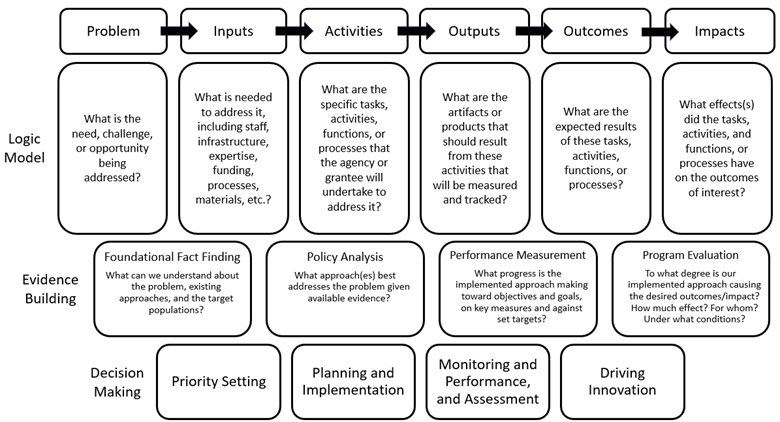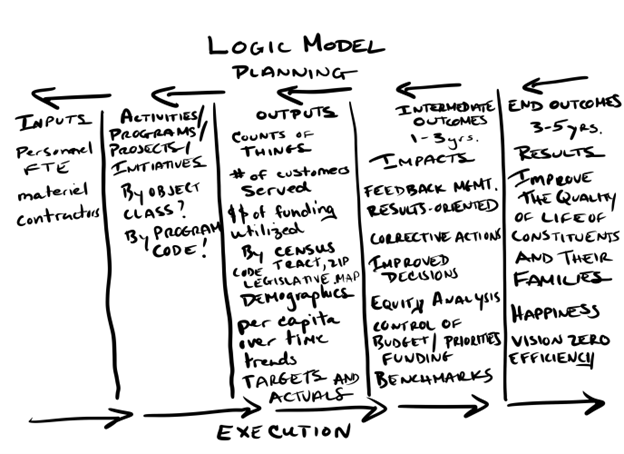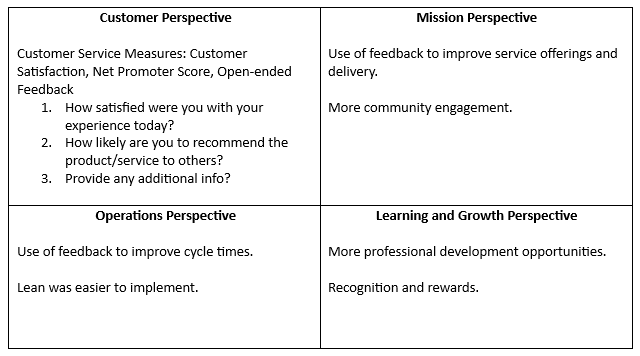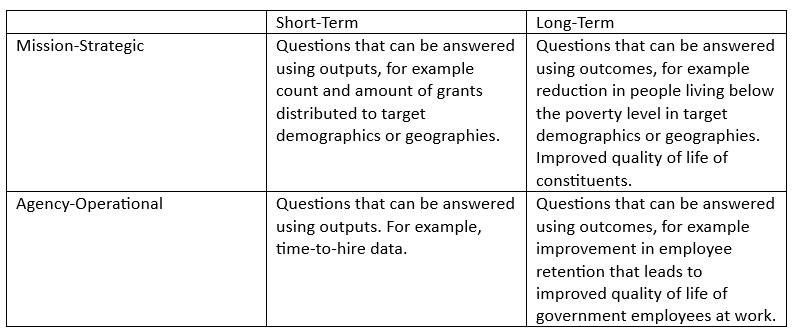In the United States Government, White House Office of Management and Budget (OMB) Circular A-11 is about Preparation, Submission, and Execution of the Budget. Part 6 of A-11 is titled ‘The Federal Performance Framework for Improving Program and Service Delivery’. Section 230 of A-11 Part 6 is titled Agency Strategic Planning and includes valuable guidance about performance management, including the theme for this post. Specifically, 230.10 is the focus of this post. It is titled ‘What is a logic model, and how can this framework tool help agencies coordinate strategic planning, strategies, and evidence?’
Section 230.10 contains a graphic that I believe is one of the most important graphics in government. This post describes how a government professional at any level of government, including federal, states, and local government professionals can use this graphic as a core tool for government performance management.

The logic model framework is also described as a best practice in other government guidance. For example, for American Rescue Plan, State and Local Fiscal Recovery Funds (SLFRF), U.S. Treasury guidance reads “recipients are encouraged to use logic models to identify their output and outcome measures. A logic model is a tool that depicts the intended links between program investments and outcomes, specifically the relationships among the resources, activities, outputs, outcomes, and impact of a program.”
An internet search for logic modeling returns a ton of results, including guidance from nearly every federal agency, and from many states and local governments. Many describe it slightly different, but the core elements are the same. Many cite the W.K. Kellogg Foundation’s Logic Model Development Guide. There the program logic model is defined as “a picture of how your organization does its work – the theory and assumptions underlying the program.
A program logic model links outcomes (both short- and long-term) with program activities/processes and the theoretical assumptions/principles of the program. We have found the logic model and its processes facilitate thinking, planning, and communications about program objectives and actual accomplishments.”
I like to describe logic models as helping to bridge the gap between strategy planning and strategy execution.
In the strategic planning process, participants plan backwards starting with the end outcomes, intermediate outcomes, outputs, activities, and inputs. Then, during strategy execution data is collected about the inputs, activities, outputs, intermediate outcomes, and end outcomes.
Practice by creating your own logic models. For example:

As the strategic planning process includes defining and refining performance measures, one technique I like to use is logic models with Balanced Scorecard. Balanced Scorecards help with strategic planning and performance measurement by examining things from four perspectives:

Using the Balanced Scorecard with logic modeling helps to examine the Evidence Building items in the OMB A-11 graphic. There is also OMB Memorandum M-19-23 titled ‘Phase 1 Implementation of the Foundations for Evidence-Based Policymaking Act of 2018: Learning Agendas, Personnel, and Planning Guidance’. In it, OMB describes the need for agencies to create learning agendas. “The Evidence Act augments ongoing agency strategic planning activities to promote better use and management of data and evidence, and agency-specific management routines, such as through data-driven performance and strategic reviews. Specifically, Learning Agendas, which identify agencies’ priority questions, drive related planning activities… Agencies should identify priority questions that, when answered, will have the biggest impact on agency functioning and performance.”
‘Identifying Priority Questions’ is a core component of creating a learning agenda. Logic modeling and Balanced Scorecard can be used.

Learning agendas and performance measures can be program specific, and needed for compliance with federal laws, regulations, and policies. It is timely to execute these techniques for federal, states, and local governments.
For example, OMB Memorandum M-22-12, Advancing Effective Stewardship of Taxpayer Resources and Outcomes in the Implementation of the Infrastructure Investment and Jobs Act (IIJA), provided initial guidance to agencies that have responsibilities for implementing IIJA programs including “detailed guidance on performance planning, measurement, and evaluation requirements. Additionally, transparency into IIJA goal setting and reporting activities by agencies will strengthen the performance management routines that support effective implementation, while also holding agencies accountable for the basis of decisions and their results. To underscore the importance of the IIJA’s implementation to agencies’ overall efforts to improve outcomes for the American public, agencies should also highlight or tag in their next annual FY 2024 Agency Performance Plan specific performance goals and measures that directly implement or align to IIJA programs. Agencies should also highlight or tag in the FY 2024 Agency Annual Evaluation Plan and/or Learning Agenda specific evidence-building activities connected to IIJA programs.”
OMB Memorandum M-21-22 directed alignment of agency strategic goals and objectives, including Agency Priority Goals, with Administration policy priorities, in particular continuing to meet the health, welfare, and economic challenges of the COVID-19 pandemic, advance equity, and address climate change.
OMB Memorandums M-21-20 and M-20-21 instructed agencies to incorporate, respectively, American Rescue Plan (ARP) and Coronavirus Aid, Relief, and Economic Security (CARES) Act funding, programs, and related efforts into existing organizational performance management routine and plans and reports.”
In summary, good performance measurement starts with logic modeling. By combining logic modeling with other decision support tools and techniques, including Balanced Scorecard helps to achieve the requirements for management and oversight of government programs. These tools also support evidence building activities, and decision making for better evidence based policymaking. Recipients of federal funds can use the graphic in section 230.10 of OMB A-11 to apply it in federal, states, and local governments to comply with laws, regulations, and policies.
Contact Information
Mike Morello
Founder, QC




